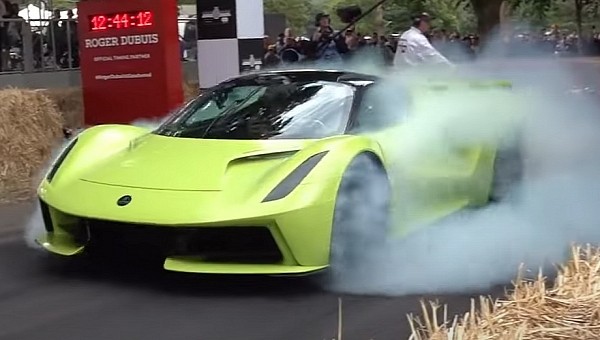Unveiled in 2019, the Lotus Evija didn't make it into production until 2022, when the British carmaker rolled the limited-edition Fittipaldi version off the assembly line. But while most customers are still waiting for their all-electric supercars, Lotus is still parading its Evija prototypes.
One of them put on quite a show at the 2022 Goodwood Festival of Speed. Although it didn't set a new record up the Goodwood Hill, the Evija covered the distance like a supercar should: fast on the straights and gracefully in the twists. And it looked right at home while driving alongside McLarens, Ferraris, and Aston Martins.
But the driver tasked with flogging the Evija at Goodwood decided to take things up a notch and used the massive power of the electric motors to do a few four-wheel burnouts. And most of them engulfed the supercar in a cloud of smoke, much to the delight of the spectators. If you still think electric cars are boring then you definitely need to watch the video below.
As a brief refresher, the Evija draws juice from four electric motors and a 93-kWh battery pack that send a whopping 2,011 horsepower (1,500 kW / 2,039 PS) and 1,257 pound-feet (1,704 Nm) of torque to all four wheels. Tipping the scales at 4,160 pounds (1,887 kg), the EV needs fewer than three seconds to hit 60 mph (96 kph) and only nine clicks to charge from zero to 186 mph (300 kph).
But the Evija isn't only about power and speed. Lotus claims that the supercar has a range of up to 250 miles (402 km) and that the battery will need only 18 minutes to go from empty to full on a 350-kWh charging station. Top speed is limited to 217 mph (350 kph), which is lower than most gasoline-fed supercars but impressive for a battery-powered rig. The Evija is built around a one-piece carbon-fiber monocoque chassis, a first for the British brand.
Lotus will manufacture only 130 examples, all of which are already accounted for. The first eight units will roll off the assembly line as Evija Fittipaldi special editions, which pay tribute to the legendary Lotus Type 72 Formula One car and Brazilian racer Emerson Fittipaldi. But I'm pretty sure more limited-edition iterations inspired by Lotus' successful motorsport past will follow.
The company's first all-electric production car costs around £2 million, which converts to about $2.4 million at the current exchange rates. But given that each Evija will be highly customized, Lotus will probably get at least $3 million a pop.
But that's enough talk for today, hit the play button below to watch the British supercar spin all four wheels and unleash a whopping 2,000 horsepower to the pavement.
But the driver tasked with flogging the Evija at Goodwood decided to take things up a notch and used the massive power of the electric motors to do a few four-wheel burnouts. And most of them engulfed the supercar in a cloud of smoke, much to the delight of the spectators. If you still think electric cars are boring then you definitely need to watch the video below.
As a brief refresher, the Evija draws juice from four electric motors and a 93-kWh battery pack that send a whopping 2,011 horsepower (1,500 kW / 2,039 PS) and 1,257 pound-feet (1,704 Nm) of torque to all four wheels. Tipping the scales at 4,160 pounds (1,887 kg), the EV needs fewer than three seconds to hit 60 mph (96 kph) and only nine clicks to charge from zero to 186 mph (300 kph).
But the Evija isn't only about power and speed. Lotus claims that the supercar has a range of up to 250 miles (402 km) and that the battery will need only 18 minutes to go from empty to full on a 350-kWh charging station. Top speed is limited to 217 mph (350 kph), which is lower than most gasoline-fed supercars but impressive for a battery-powered rig. The Evija is built around a one-piece carbon-fiber monocoque chassis, a first for the British brand.
Lotus will manufacture only 130 examples, all of which are already accounted for. The first eight units will roll off the assembly line as Evija Fittipaldi special editions, which pay tribute to the legendary Lotus Type 72 Formula One car and Brazilian racer Emerson Fittipaldi. But I'm pretty sure more limited-edition iterations inspired by Lotus' successful motorsport past will follow.
The company's first all-electric production car costs around £2 million, which converts to about $2.4 million at the current exchange rates. But given that each Evija will be highly customized, Lotus will probably get at least $3 million a pop.
But that's enough talk for today, hit the play button below to watch the British supercar spin all four wheels and unleash a whopping 2,000 horsepower to the pavement.










